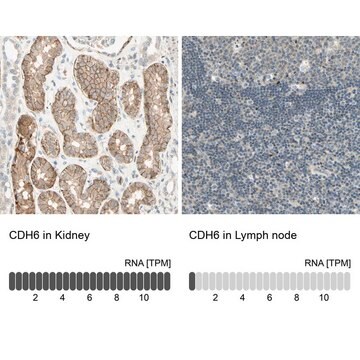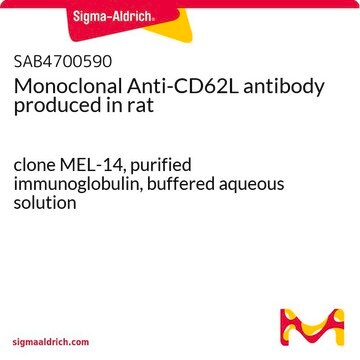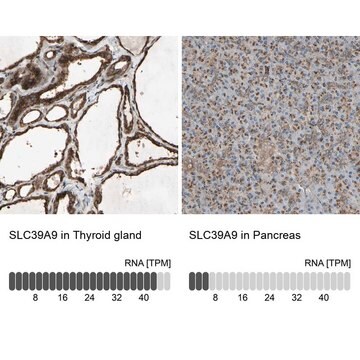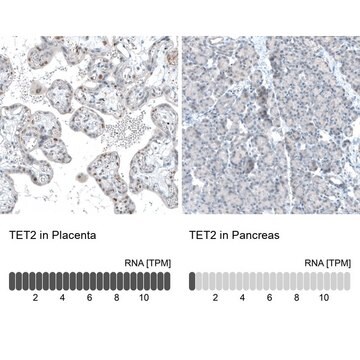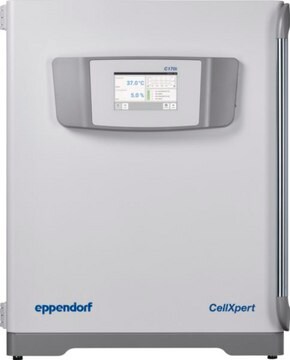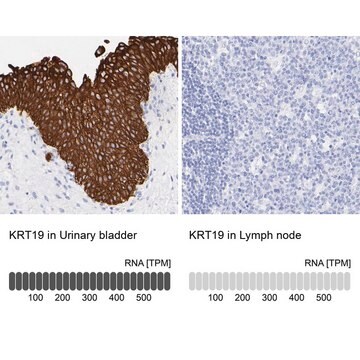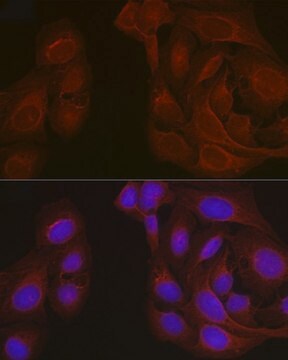推薦產品
生物源
rabbit
共軛
unconjugated
抗體表格
affinity isolated antibody
抗體產品種類
primary antibodies
無性繁殖
polyclonal
產品線
Prestige Antibodies® Powered by Atlas Antibodies
形狀
buffered aqueous glycerol solution
物種活性
human
技術
immunoblotting: 0.04-0.4 μg/mL
immunohistochemistry: 1:200-1:500
免疫原序列
ERASIDEAYVDLTSAVQERLQKLQGQPISADLLPSTYIEGLPQGPTTAEETVQKEGMRKQGLFQWLDSLQIDNLTSPDLQLTVGAVIVEEMRAAIERETGFQCSAGISHNKVLAKLACGLNKPNRQTLVSHGSVPQLFSQMPIRKIRSL
UniProt登錄號
運輸包裝
wet ice
儲存溫度
−20°C
目標翻譯後修改
unmodified
基因資訊
human ... POLH(5429)
一般說明
DNA polymerase η is a member of Y family of specialized DNA polymerases, encoded by skin cancer susceptibly gene POLH or XPV (xeroderma pigmentosum variant), mapped to human chromosome band 6p21.1-6p12. The gene with 11 exons, spanning whole coding sequence, does not contain TATA sequence in the upstream region of the transcription-initiation. DNA polymerase η is a human homologue of the yeast Rad30 protein and it belongs to the damage-bypass replication protein family.
免疫原
polymerase (DNA directed), eta recombinant protein epitope signature tag (PrEST)
應用
All Prestige Antibodies Powered by Atlas Antibodies are developed and validated by the Human Protein Atlas (HPA) project and as a result, are supported by the most extensive characterization in the industry.
The Human Protein Atlas project can be subdivided into three efforts: Human Tissue Atlas, Cancer Atlas, and Human Cell Atlas. The antibodies that have been generated in support of the Tissue and Cancer Atlas projects have been tested by immunohistochemistry against hundreds of normal and disease tissues and through the recent efforts of the Human Cell Atlas project, many have been characterized by immunofluorescence to map the human proteome not only at the tissue level but now at the subcellular level. These images and the collection of this vast data set can be viewed on the Human Protein Atlas (HPA) site by clicking on the Image Gallery link. We also provide Prestige Antibodies® protocols and other useful information.
The Human Protein Atlas project can be subdivided into three efforts: Human Tissue Atlas, Cancer Atlas, and Human Cell Atlas. The antibodies that have been generated in support of the Tissue and Cancer Atlas projects have been tested by immunohistochemistry against hundreds of normal and disease tissues and through the recent efforts of the Human Cell Atlas project, many have been characterized by immunofluorescence to map the human proteome not only at the tissue level but now at the subcellular level. These images and the collection of this vast data set can be viewed on the Human Protein Atlas (HPA) site by clicking on the Image Gallery link. We also provide Prestige Antibodies® protocols and other useful information.
生化/生理作用
DNA polymerase η (polη) catalyzes an accurate trans-lesion DNA synthesis, suggesting that the XPV (xeroderma pigmentosum variant) gene encoding this protein has a role in tumor suppression in normal individuals. Mutation in this DNA polymerase leads to an inherited disorder called Xeroderma pigmentosum variant (XP-V). DNA polymerase η plays a vital role in repairing UV-induced DNA damage by replacing the major UV-induced lesion with two adenines. DNA polymerase η facilitates hypermutation of immunoglobulin variable genes.
特點和優勢
Prestige Antibodies® are highly characterized and extensively validated antibodies with the added benefit of all available characterization data for each target being accessible via the Human Protein Atlas portal linked just below the product name at the top of this page. The uniqueness and low cross-reactivity of the Prestige Antibodies® to other proteins are due to a thorough selection of antigen regions, affinity purification, and stringent selection. Prestige antigen controls are available for every corresponding Prestige Antibody and can be found in the linkage section.
Every Prestige Antibody is tested in the following ways:
Every Prestige Antibody is tested in the following ways:
- IHC tissue array of 44 normal human tissues and 20 of the most common cancer type tissues.
- Protein array of 364 human recombinant protein fragments.
聯結
Corresponding Antigen APREST71087
外觀
Solution in phosphate-buffered saline, pH 7.2, containing 40% glycerol and 0.02% sodium azide.
法律資訊
Prestige Antibodies is a registered trademark of Merck KGaA, Darmstadt, Germany
免責聲明
Unless otherwise stated in our catalog or other company documentation accompanying the product(s), our products are intended for research use only and are not to be used for any other purpose, which includes but is not limited to, unauthorized commercial uses, in vitro diagnostic uses, ex vivo or in vivo therapeutic uses or any type of consumption or application to humans or animals.
Not finding the right product?
Try our 產品選擇工具.
儲存類別代碼
10 - Combustible liquids
水污染物質分類(WGK)
WGK 1
閃點(°F)
Not applicable
閃點(°C)
Not applicable
分析證明 (COA)
輸入產品批次/批號來搜索 分析證明 (COA)。在產品’s標籤上找到批次和批號,寫有 ‘Lot’或‘Batch’.。
The human POLH gene is not mutated, and is expressed in a cohort of patients with basal or squamous cell carcinoma of the skin.
Flanagan AM
International Journal of Molecular Medicine, 19(4), 589-596 (2007)
X Zeng et al.
Nature immunology, 2(6), 537-541 (2001-05-29)
To determine whether DNA polymerase eta plays a role in the hypermutation of immunoglobulin variable genes, we examined the frequency and pattern of substitutions in variable VH6 genes from the peripheral blood lymphocytes of three patients with xeroderma pigmentosum variant
M Yuasa et al.
Oncogene, 19(41), 4721-4728 (2000-10-14)
The xeroderma pigmentosum variant (XP-V) is one of the most common forms of this cancer-prone syndrome. XP groups A through G are characterized by defective nucleotide excision repair, whereas the XP-V phenotype is proficient in this pathway. The XPV gene
C Masutani et al.
Nature, 399(6737), 700-704 (1999-06-29)
Xeroderma pigmentosum variant (XP-V) is an inherited disorder which is associated with increased incidence of sunlight-induced skin cancers. Unlike other xeroderma pigmentosum cells (belonging to groups XP-A to XP-G), XP-V cells carry out normal nucleotide-excision repair processes but are defective
我們的科學家團隊在所有研究領域都有豐富的經驗,包括生命科學、材料科學、化學合成、色譜、分析等.
聯絡技術服務
